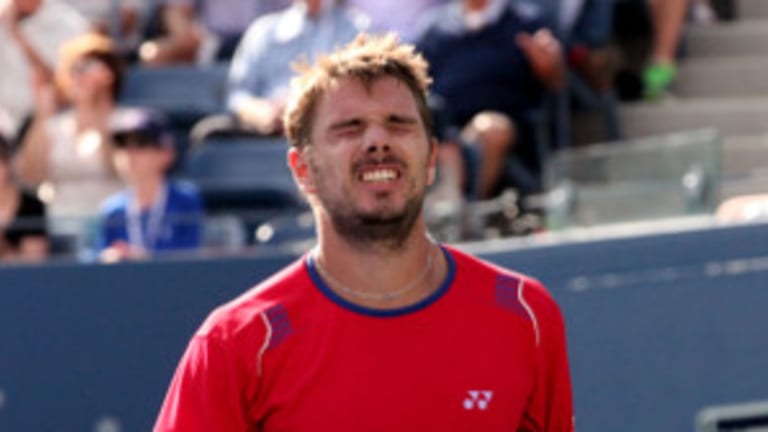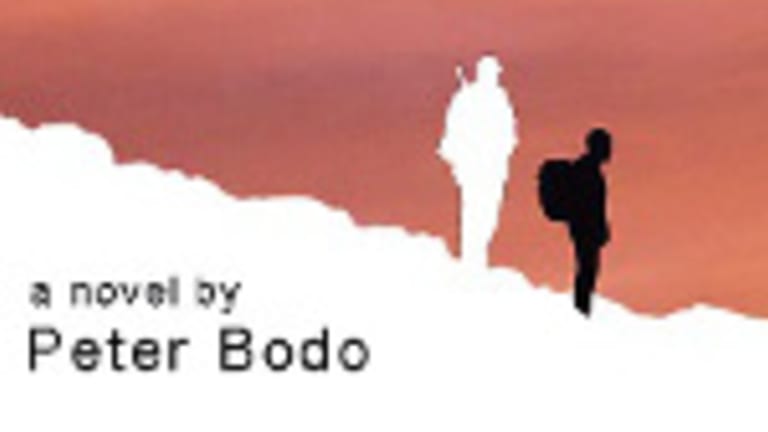NEW YORK—In what might someday be remembered by those who witnessed it as “The Game,” the two warriors in short pants stood in the late afternoon sunshine as wave after wave of adulatory noise cascaded over them in Arthur Ashe Stadium. They were blanketed in sound as dense and rich as the late afternoon sun in which they already were bathed.
The Game, with Stanislas Wawrinka serving, was almost exactly 20 minutes long by that time, and once again the men were deadlocked at deuce. As Wawrinka stood drinking in the atmosphere during this standing ovation, he couldn’t help but smile. He was trying—Lord knows he was trying. But it was top-seeded and top-ranked Novak Djokovic across the net, trying to slash his way to a fourth consecutive U.S. Open final.
Wawrinka appeared to recognize that the impasse to at which he and Djokovic had arrived, like two rubbery-armed prizefighters who could no longer do anything but stand flat-footed and fail to knock each other out, was something rare, so he did the only logical thing under the circumstances. He embraced the moment, looking out over the crowd, a smile breaking across his stressed face. A lengthy moment later, he gently shrugged his shoulders: “What can I do?”
Meanwhile, at the far end of the court, Djokovic prowled just behind his baseline like an impatient wolf that innately understands that he can take his prey, but only if he waits until the right time comes. He was patient. He trusted his reserves of energy. And he liked what he saw across the net. He may not have had the shots to beat Wawrinka on this day, but he had the legs and the patience.
Wawrinka would go on to hold serve in that 21-minute, 30-point game (surviving five Djokovic break points) to take a 2-1 lead in the fifth set. But despite the immediate boost to his morale, he knew that Djokovic was making him pay too high a price for that, and other, games. He knew that, as the saying goes, the wolf was at the door.
“Yeah, it was a really long game with some good points and some big mistake. He was quite nervous,” Wawrinka said of that endless game. “I was really tired. I was struggling physically, and it was not easy to keep the level quite high. But for me it was just important to fight, and not to let him go and not to lose 6-1 or 6-2, but just to try to get every game I can.”
Wawrinka accomplished his goal even if the fatigue he felt, the accumulated toll of two long, tense previous matches (against Marcos Baghdatis and Tomas Berdych, before beating Andy Murray) was not to be denied. After The Game, his quads felt like bags of water and his arm was so heavy that it became much easier to hit the downhill slice backhand than the one for which he is more famous—the rolled, low-to-high topspin detonation and statement that ends with the racquet high overhead in a triumphant gesture.
The end was inevitable: The wolf won it on the strength of his legs and will, 2-6, 7-6 (4), 3-6, 6-3, 6-4. And he was under no illusions about how it had all happened.
“Wawrinka was a better player for most of the match, because he was aggressive and played better,” Djokovic suggested afterward. “I just tried to hang on and fight and believe all the way through I can actually win, and I sincerely believe that as the match progresses and the longer it goes, I felt I have maybe that physical edge over him.”
That edge was not visible until the final set of this match, even though Wawrinka had taken a brief injury timeout after Djokovic broke serve and held for 4-1 in what had become the critical fourth set. Even then, there were interludes during which Wawrinka, after playing a point that appeared to show his fatigue, would smack a series of stone-cold winners to keep the wolf at bay. While this match’s loser won five of the nine break points he saw, Djokovic was a ghastly four for 19—the terrible percentage softened considerably by the almost eerie way Wawrinka was able to muster his best tennis at times of duress. There was nothing wrong with his shotmaking; his problem was in his corporeal being. It was exactly the reverse with Djokovic.
The way Djokovic built this victory on an unlikely combination of fitness, self-belief, patience, and a realistic recognition of his plight is a vivid demonstration of a great player’s ability to accommodate frustration and still find a way to win. It was doubly impressive because as anyone could see, Djokovic was plagued by nerves and out of sorts through a lopsided first set. He rallied his game slowly and, in truth, with only sporadic success.
“I knew that he’s gonna come out with big backhands and be aggressive, so I tried to be close to the (base)line,” Djokovic said. “But I wasn’t managing to find my rhythm. That’s what frustrated me. I wasn’t hitting the ball well. A lot of unforced errors. But it was one of those days, you know, where even if you don’t feel well on the court you have to be tough and believe that you can win.”

